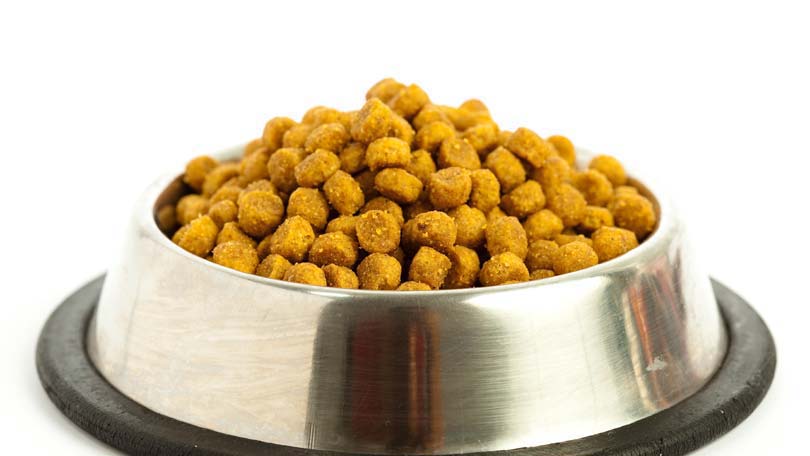
Few people today remember feeding their pets anything but a commercial diet but at one time, all dogs were fed table scraps and whole foods. In the mid 1800’s, James Spratt produced a dry biscuit made from grains, vegetables and meat. His product was convenient and promised balanced nutrition and soon his business exploded. In 1890 he sold the company to a larger corporation and production started in the US as well.
Canned horsemeat became common in the US after WWI and in the 1930’s canned cat food hit the shelves as well as a ‘dry meat meal’ for dogs produced by Gaines Food Co. During WWII when the metal from canning was needed for the war effort, the canned pet food industry nearly went under entirely. With the end of the war came a revival however and soon major food manufacturers such as Quaker Oats, General Foods, and Nabisco jumped on the commercial pet food bandwagon.
In 1956, the first extruded ‘kibble’ was produced and the commercial dog food industry has never looked back! Extrusion is the process with which the ingredients are pressed into kibble and then cooked.
From there, pet food manufacturers continued to refine the process and produce marketing that appealed to consumers focused on the convenience and balanced nutrition of pet food. As prescription and breed specific formulas developed and emphasis was placed on feeding to the needs of individual animals, the pet food industry grew to the 15 billion dollar industry it is today.
Facts about Feeding Dogs
Is commercial pet food better for your dog? Can a homemade diet offer more for your dog then pet food? Is a raw diet a healthier option?
With so many dog food brands on the market today along with the controversy over a growing number of food allergies and food related conditions, the decision on what to feed your dog has become more then a challenge – its become a nightmare!
How do you decide what is the best way to feed your dog or pick a brand of food? You start with the facts about feeding dogs and base your decision on the truth, not the hyped up marketing tactics of the various proponents within the dog food debate.
Commercial Dog Foods Facts
Is the pet food industry the monster that many raw and homemade pet food advocates would like you to believe? Honestly, it can be but the quality largely depends on the manufacturer and like most things in life: buyer beware!
The facts about feeding dogs a commercial diet are:
The quality of the food is largely dependent on the quality of the ingredients. Cheap food to purchase means cheap ingredients and fillers were used to make the finished product. Always buy the best quality food you can afford – it will save you money in vet bills in the end!
If you cannot pronounce an ingredient, it does not mean the food is full of chemicals. Learn the names of the common and FDA approved preservatives and nutrients that are added to pet food so you are not fooled by the sometimes confusing ingredients.
All natural does not mean anything in terms of food quality. Looking for food non-GMO grains without pesticides or insecticides and meat free of steroids, hormones, and antibiotics? Then you are looking for ‘organic’ dog food. All natural loosely means that the food has not been over processed, but guaranteed, if a manufacturer has gone the extra mile to two to use only organic ingredients, the last thing would do is risk losing nutrients or lower the quality of their food through over processing.
Are road kill, euthanized pets, or diseased livestock used to make commercial pet food? It would be foolhardy to say it has never been done in the past but with new tougher FDA regulations negate the chance of it ever happening again. When choosing a food for your dog, find one with the FDA approved stamp and always buy the best quality food you can afford.
Are prescription diets necessary? In a word, yes. If you have a heart condition and your doctor says you must cut down on fat and salt, do you listen to him? Yes. So why would you ignore the same advice for your dog?
Commercial dog food is not the ogre that homemade food advocates think it is and it does have one highly redeeming quality: it is convenient. If you would rather be exercising and training your dog then cooking for him, do not berate yourself for feeding kibble. Buy a top-quality food that fits his nutritional requirements and rest assured you are providing him with all that he needs.
Homemade Dog Diet Facts
Is a homemade diet better for your dog? Again, it depends on many factors. Are you thinking a cooked, nutritionally balanced meal that takes into consideration your dog’s unique requirements? Are you willing to talk to a veterinary nutritionist to build a meal plan and have your pet’s health monitored?
The facts about feeding dogs a homemade diet:
Like commercial dog foods, the quality of the finished product is entirely dependent on the quality of the ingredients. Many people who feed homemade diets buy cheap meat and scraps from butchers to save a few dollars meanwhile the compromising their pet’s health by bombarding them with steroids, hormones and antibiotics.
The belief that dogs are carnivores tends to make owners want to feed dogs all meat diets or, in other words, pure protein. Dogs are omnivores – they require complex carbohydrates and vegetables. Homemade food must be a complete and balanced diet.
Raw and BARF (Bones And Raw Food) diets are dangerous to your pet’s health. Many advocates of feeding uncooked meat and raw bones say that this is how the canine ancestors ate and there is some truth to their arguments. However, the ancestors of our dogs lived an average of five years, not fifteen and who’s to say their natural ability to fight off bacteria such as salmonella and e.coli was not greater. Today, the risk of exposing your dog to these dangerous bacteria outweighs the potential health benefits of a raw of BARF diet.
A well-balanced, nutritionally complete homemade diet can be the perfect solution for many dogs, especially those with food allergies. Do you feel equipped to feed your dog from your kitchen? Ready to buy and prepare fresh, high quality cuts of meat and poultry along with whole grains and vegetables? Consider the pros and cons of a homemade diet and decide whether or not the time commitment involved is worth it in the end.
The facts about feeding your dog properly boils down to one simple conclusion: whether it is commercial dog food or a homemade diet, always buy the best quality food you can afford. The quality of the ingredients make or break the quality of the food and in our consumer based society, you get what you pay for!





